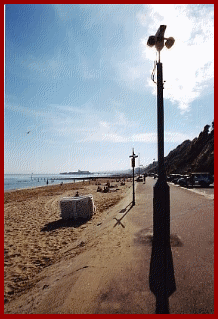| ||||||||||||||||||||||||||||||
Welcome to the | ||||||||||||||||||||||||||||||
 | ||||||||||||||||||||||||||||||
 | ||||||||||||||||||||||||||||||
Making light of a dark place ... | ||||||||||||||||||||||||||||||
If the camera is set up to look at individuals walking along a path past a high brick wall, or perhaps a tall hadge (or even a row of evergreen trees), simply position the IR lamp so its output is reflected off the wall or foliage, which will then create a gentle diffuse form of lighting, with greatly reduced shadows and a better overall balance to the exposure. With indoor applications, Doktor Jons preferred option will always be ...... to ‘bounce’ the light off the ceiling! One word of warning though,as has already been mentioned, tungsten filament based illuminators not only get hot, but they also project heat for some distance in front of them; if you are going to ‘bounce the light’, just make sure that the reflective surface isn’t about to burst into flames!! It was mentioned at the beginning that Infra Red frequencies, behave pretty much the same as visible light, but there is an obvious problem with the camera lenses. All glass elements are described as having a ‘refractive index’ which is basically an indication of the way they affect the passage of light as it passes through. The problem with IR light is that it doesn’t bend to the same degree as other visible frequencies such as blue or green. If a lens has been set up and focussed under visible conditions, apart from the possibility of ‘depth of field’ coming to the rescue, there is a reasonable chance that the lens will need to be slightly refocused for use under IR conditions. Interestingly enough, there are a very limited number of specialist lenses made with extremely low dispersion glass that bends the IR to focus at the same point as visible wavelengths, but unfortunately there is no such thing as a free lunch .... these optics generally cost 3 -4 times as much as the normal equivalent. Remember also that anything in the light path, such as a Neutral Density filter or a dome housing cover, may well affect the overall picture quality, and possibly also the degree of Infra Red transmission. | ||||||||||||||||||||||||||||||
 | ||||||||||||||||||||||||||||||
IMPORTANT: No material may be reproduced, copied or redistributed from this site, © doktorjon.co.uk 2004 - 2008 Homepage...:...Gateway...:...Technical Gateway....:....Quickfind Index....:....Equipment Directory | ||||||||||||||||||||||||||||||

